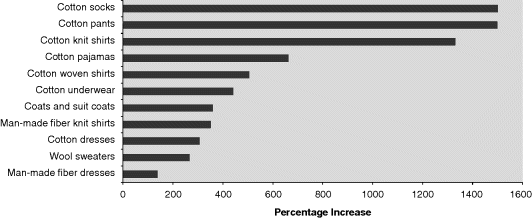1245 Years of ‘‘Temporary ’’ Protectionism end in 2009–Now What?
The Big Bang
Despite the scrambling by Auggie and his troops, as well as the support from his allies around the world, the final tranche of textile and apparel quotas was lifted as scheduled on January 1, 2005. The surges from China were everything Auggie had feared. As Figure 12.1 shows, for some categories released from quota, China's exports to the United States soared by more than 800 percent during the first four months of 2005, compared to the same period in the preceding year. The T-shirt, or cotton knit shirt category, showed import surges in excess of 1,200 percent. Overall, the average increase across all categories released was slightly more than 400 percent. It was a flood, and it did indeed appear that many firms in the United States and around the world would soon drown.

Figure 12.1 Percentage Increase in U.S. Imports from China for Categories Released from Quota on January 1, 2005. January–April 2005 Compared to January–April 2004.
Source: Author's calculations from OTEXA trade data. Data in square meter equivalents.
My first thought, as I followed the trade developments in early 2005, was that we were finally seeing—after decades of political control—what free trade in apparel would look like. Though there remained multiple complex agreements governing apparel trade, the most stultifying regime ...
Get The Travels of a T-Shirt in the Global Economy: An Economist Examines the Markets, Power, and Politics of World Trade. New Preface and Epilogue with Updates on Economic Issues and Main Characters, 2nd Edition now with the O’Reilly learning platform.
O’Reilly members experience books, live events, courses curated by job role, and more from O’Reilly and nearly 200 top publishers.

